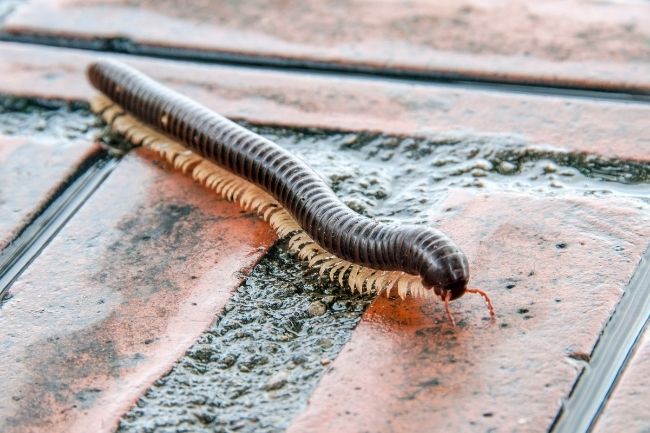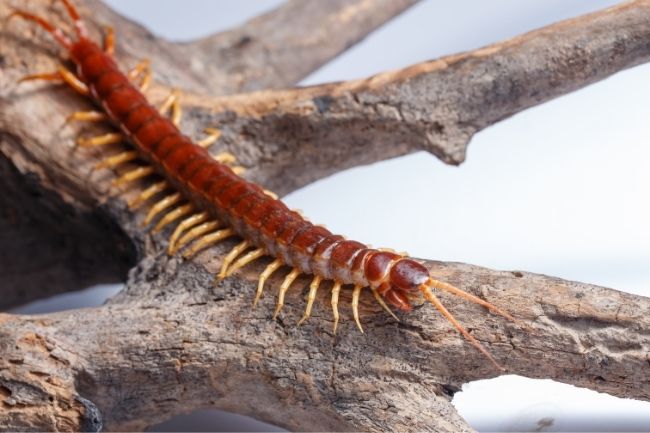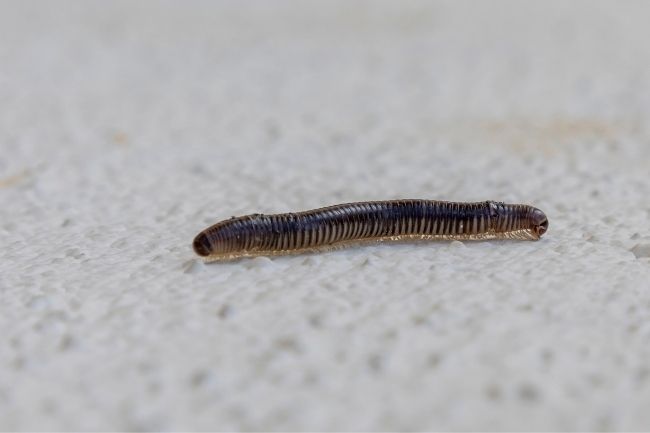Millipedes and centipedes can be differentiated in a number of ways. Centipedes are usually flatter, with fewer legs and are carnivorous, whereas millipedes are rounder with more legs and feed on plant matter.
Contents
What’s the difference?

For many people, the difference between millipedes and centipedes isn’t immediately apparent. Both are small, elongated invertebrates with lots of legs, that like to hang out under rocks or skitter across the soil.
One of the reasons that they are so similar is that they are very closely related. Both are Myriapods, meaning they have large number of common features.
| Characteristic | Millipedes | Centipedes |
|---|---|---|
| Number of Legs | Many pairs of legs (typically 2 per segment) | One pair of legs per segment |
| Body Segmentation | Long and cylindrical body with many segments | Long and flattened body with fewer segments |
| Leg Structure | Short and stubby legs | Long and slender legs |
| Antennae | Present | Present or absent (depending on the species) |
| Coloration | Usually brown or black | Various colors, including brown, red, or yellow |
| Mode of Movement | Slow and steady crawling | Fast and agile movement |
| Characteristic | Millipedes | Centipedes |
|---|---|---|
| Feeding Habits | Mostly herbivorous, feeding on decaying plant material | Predatory, feeding on small insects, spiders, and invertebrates |
| Ecological Role | Decomposers, aiding in the breakdown of organic materials | Controlling populations of insects and other invertebrates |
| Habitat | Moist environments, such as leaf litter and soil | Diverse habitats, including soil, leaf litter, and vegetation |
| Defensive Tactics | Curling into a protective coil when threatened | Venomous bite and quick movement for defense |
| Reproduction | Mostly sexual, some species reproduce asexually | Mostly sexual reproduction |
However, while a quick glance may have you thinking you could never tell the two apart, there are plenty of important differences between these two groups.

1) Diet
Diet is a key difference between the two groups, as it affects their lifestyles and their body shape.
Millipedes are detritivores, meaning they eat dead plant matter and other rotting things. This means they spend their time wandering around looking for tasty piles of waste.
Centipedes by comparison are carnivores, meaning meat-eaters, and ferocious predators. They spend their time hunting for unsuspecting invertebrates, and some of the biggest species even preying on small rodents.
Also read: Is a Dragonfly a Vertebrate or an Invertebrate?
2) Shape
Although there are some exceptions to the rules, in the majority of species the centipede is a tubular, rounded shape. This is a good shape for tunnelling, which can help them in finding rotting plant matter.
Centipedes, on the other hand, are a much flatter shape. This flatter body form can be useful to help them squeeze into crevices and hunt out little invertebrates hiding there.
3) Number of legs
While you may think you know how many legs centipedes and millipedes have from their names, you would sadly be mistaken. While centipede means a hundred legs and millipedes, a thousand legs, both fall short of these goals the majority of the time.
Millipedes generally have between 100 and 400 legs, though one species has been found with 1,300 legs. Centipedes are even less dramatic, with around 15 to 170 legs in general.

What helps millipedes fit in so many more legs is that they have two legs per segment, apart from on the first few. This is because, at some point, two segments of the millipede fused into one. Centipedes by comparison only have one leg per segment.
Interestingly, the number of legs also changes throughout their lives. Baby millipedes are born without legs, and they gain more segments and legs with each moult. Baby centipedes tend to be born with four legs, and like millipedes, they gain more legs over time with each moult.
4) Speed
Speed is something that can be particularly obvious to an observer. In general, centipedes are much faster than millipedes. Millipedes are somewhat slowed down by their many legs.
Speed is important for their various feeding methods, with centipedes needing to be faster as they are hunters, whereas millipedes can take their time when hunting down a rotting piece of wood.
5) Toxicity
Both millipedes and centipedes contain toxic substances that they use in various ways to help with their survival.
Centipedes use their toxins to aid in their hunting process. Behind the centipede’s head, they have a set of adapted legs called maxillipeds. With these they can grasp and inject their prey, leading to death or paralysis. As the toxins centipedes use are meant for much smaller creatures, there is generally little danger to humans, though some can be painful.
As millipedes do not hunt, their toxins are designed to prevent them from being eaten. Millipedes have a series of pores along with their bodies, from which the toxins are excluded if they feel threatened. In these instances, millipedes generally curl into a tight ball to protect themselves. The toxins taste unpleasant and can make the animal attempting to eat them ill, but they can also give off a foul smell, making it more likely the millipede will be left unmolested.
6) Spiracles
Millipedes and centipedes do not have lungs, instead, they have openings within their exoskeletons called spiracles. These openings allow air to enter into the body of the animals through the forces of air pressure, rather than being pulled in.
Once inside, the air travels through steadily branching tubes to be delivered directly to vital organs.
While both millipedes and centipedes have spiracles, the number varies between the two groups. Millipedes have two spiracles per segment, and they are located just above their legs. Centipedes by comparison have one or fewer spiracles per segment.
7) Mating
Millipedes are largely solitary animals, however, they do require a mate to reproduce. However, do not require copulation, with the male simply leaving a sperm package for the female to retrieve and use.
Centipedes do copulate. With the male courting the female before positioning himself and mating with her directly.
8) Antennae
Arthropod species have a wide range of antennae forms, from the plume-like antenna moth species possess to the club-like antenna of some beetles. All these different antennae help these animals to sense different things and use their antennae in different ways.
Centipedes have very obviously elbowed antennae, which can help them to reach out and sense things quickly when they are on the hunt. Millipedes, by comparison, have long thread-like antennae, which they can use to sense the environment more immediately surrounding them.
Also read: How Butterflies Taste? With Feet, Antenna or Tongue?
9) Back legs
Many species of arthropods have particular parts of their colouring or anatomy that are designed to distract attention away from their heads. This is because their heads are the most important parts of their bodies. While they might be able to survive a bite to another part of their body, they will not survive a direct bite to their heads.
On centipedes, the final pair of legs have been adjusted, being longer than the rest. This mimics the antennae on the head of the centipede. This makes any attacker aim for the wrong end of the centipede and gives the animal time to turn around and attack. Millipedes on the other hand generally do not have these altered back legs.
Similar but different
So while millipedes and centipedes are very similar, there are plenty of differences to help tell them apart, from the number of legs they have, to the shape of their antennae. Perhaps the biggest difference is how they live their lives, with one a ferocious hunter, while the other gently grazes on discarded waste. Both are ancient and fascinating animals that have wandered the earth far longer than humans.
Therefore, while they may not be the most cuddly of creatures, they certainly have their place in our world, scuttling through the leaf litter or crawling under rocks.

